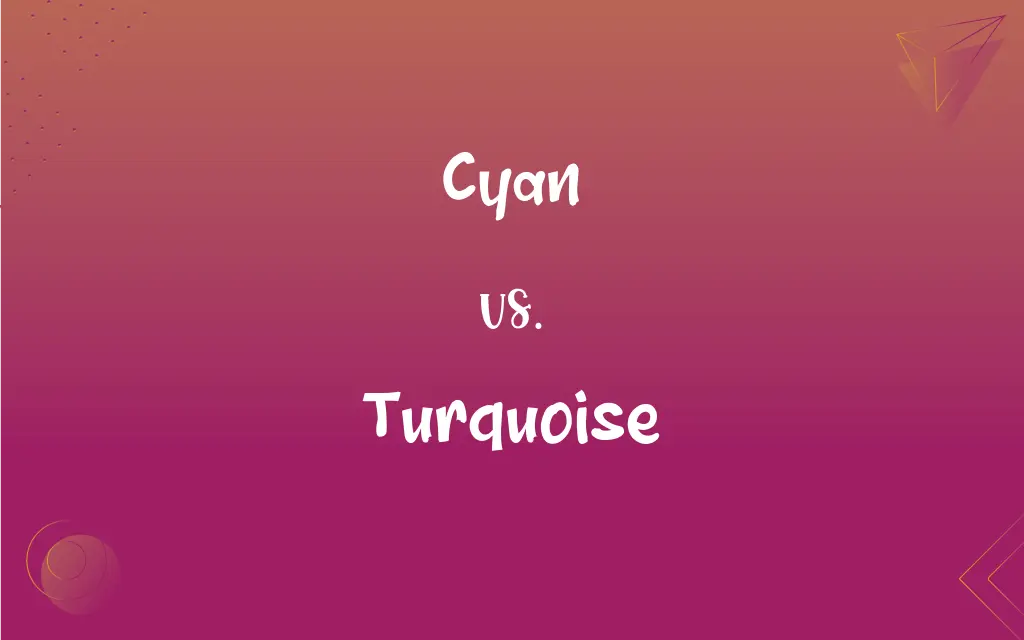Cyan vs. Turquoise: What's the Difference?
Edited by Harlon Moss || By Janet White || Updated on October 5, 2023
Cyan is a greenish-blue color, while turquoise, also a blue-green hue, tends to be less blue and slightly more green and pale.

Key Differences
Cyan is one of the subtractive primary colors used in color printing and photography and is commonly associated with a vibrant, electric hue. Turquoise, named after the gemstone, manifests a somewhat greenish tint, veering towards a paler, yet still vibrant, blue-green.
Cyan can be realized as a more electric and brighter color, frequently used in the CMYK color model, essential in color printing. Turquoise presents a subtler aesthetic, often associated with southwestern and Persian art and decor due to the gemstone's historical use in these areas.
Cyan is often considered a fundamental color in technical contexts, especially in printing and digital display color models. On the contrary, turquoise is not standard in technical models but is well-established in colloquial and artistic contexts.
In a digital context, especially in RGB settings, cyan is often distinctly noticeable and can be identified by its specific color codes. In contrast, turquoise may have varied interpretations in digital settings, with specific codes often varying between different design platforms.
Cyan's identity within cultural or artistic realms is often overshadowed by its technological relevance, particularly in printing. Turquoise, however, has been widely recognized for centuries, notably through the eponymous gemstone and the vibrant color it has imparted to artifacts and jewelry.
ADVERTISEMENT
Comparison Chart
Technical Usage
Prominent in CMYK and RGB models
Less standardized in technical models
Brightness
Typically brighter and more electric
Softer, often paler
Cultural Association
More modern and technological
Historically and artistically rich
Tint
Leans towards blue
Leans towards green
Material Association
Not commonly associated with physical materials
Associated with turquoise stones
ADVERTISEMENT
Cyan and Turquoise Definitions
Cyan
A pigment used in various artistic mediums.
He added cyan to the palette to brighten the ocean scene.
Turquoise
A historic and cultural symbol in southwestern jewelry.
The turquoise embedded in the bracelet held cultural significance.
Cyan
A greenish-blue color used in the CMYK color model.
The printer is out of cyan ink.
Turquoise
A shade associated with fashion and decor.
The cushions were a vibrant turquoise, adding a pop of color to the room.
Cyan
One of the colors of the visible spectrum.
Cyan is positioned between green and blue in a rainbow.
Turquoise
A semi-precious stone that has a blue-to-green color spectrum.
Her necklace was adorned with turquoise beads.
Cyan
A color often utilized in graphic design.
The graphic artist opted for cyan to create a vibrant look.
Turquoise
A blue to blue-green mineral of aluminum and copper, mainly CuAl6(PO4)4(OH)8·4H2O, prized as a gemstone in its polished blue form.
Cyan
A hue used in digital screen color displays.
She chose a bright cyan for her website’s header.
Turquoise
A light to brilliant bluish green.
Cyan
A greenish blue, one of the subtractive primary colors.
Turquoise
(countable) A sky-blue, greenish-blue, or greenish-gray semi-precious gemstone.
Cyan
A vibrant pale greenish-blue colour between blue and green in the visible spectrum; the complementary colour of red; the colour obtained by subtracting red from white light.
Turquoise
A pale greenish-blue colour, like that of the gemstone.
Cyan
Of the colour cyan.
Turquoise
Made of turquoise (the gemstone).
Cyan
A blue-green that is one of the primary pigments
Turquoise
Having a pale greenish-blue colour.
Cyan
A bluish shade of green
Turquoise
A hydrous phosphate of alumina containing a little copper; calaite. It has a blue, or bluish green, color, and usually occurs in reniform masses with a botryoidal surface.
Turquoise
Having a fine light blue color, like that of choice mineral turquoise.
Turquoise
A blue to gray green mineral consisting of copper aluminum phosphate; blue turquoise is valued as a gemstone
Turquoise
A shade of blue tinged with green
Turquoise
A bluish-green color resembling the turquoise stone.
The ocean shimmered in varying shades of turquoise.
Turquoise
A color often associated with tranquility and calm.
The room was painted turquoise to evoke a peaceful ambiance.
FAQs
Is Turquoise generally considered brighter than Cyan?
No, Cyan is usually considered brighter and more electric, while Turquoise tends to be somewhat softer and paler.
Is Turquoise mentioned in historical texts?
Yes, Turquoise has historical mentions due to the stone, unlike Cyan, which doesn't have extensive historical references.
Are Cyan and Turquoise used in printing?
Cyan is a standard color in printing (CMYK), while Turquoise is not standardized in the printing industry.
Is "Cyan" derived from a natural substance, like "Turquoise"?
No, "Cyan" is derived from the Greek word "kyanos," meaning dark blue, while "Turquoise" refers to a semi-precious stone.
Can Cyan be used to describe a gemstone's color?
Rarely. Unlike Turquoise, Cyan is not commonly used to describe gemstone colors.
Are Cyan and Turquoise primary colors in any color model?
Cyan is a primary color in the subtractive (CMYK) color model, but Turquoise is not a primary color in standard models.
Are Cyan and Turquoise easily distinguishable to most people?
They may be distinguishable, but some people might find them quite similar due to their blue-green characteristics.
Are Cyan and Turquoise culturally significant in any regions?
Turquoise is culturally significant in regions like the American Southwest and the Middle East, while Cyan doesn’t have such strong cultural ties.
Can Cyan and Turquoise be naturally occurring colors?
Yes, both can be found in nature, but Turquoise is also a naturally occurring gemstone.
Do Cyan and Turquoise have standardized shades in digital media?
Cyan has a standardized shade in digital contexts, but Turquoise can vary between platforms and design applications.
Is Cyan commonly used in visual media?
Yes, due to its primary color status in the CMYK model, it is commonly used in various visual media.
Is Turquoise used in artistic mediums?
Yes, Turquoise is used in various artistic mediums, though not as commonly as Cyan in things like digital art due to its standardized status.
Do Cyan and Turquoise have psychological effects?
Anecdotally, Turquoise is often considered calming, and Cyan is viewed as vibrant and energizing, though responses can be subjective.
Are Cyan and Turquoise popular in fashion design?
Turquoise has been popular in various fashion eras due to its gemstone and calming color, while Cyan has seen usage in more modern and tech-inspired designs.
Can both Cyan and Turquoise be found in the RGB color model?
Yes, both colors can be created in the RGB model, but Cyan is often more prominently recognized.
How are Cyan and Turquoise used in interior design?
Cyan might be used for a bright, bold aesthetic, while Turquoise is often utilized for a softer, tranquil environment.
Do Cyan and Turquoise have symbolic meanings?
Turquoise often symbolizes calm and tranquility, while Cyan doesn’t have universally accepted symbolic meanings.
Are Cyan and Turquoise found in national flags?
Yes, variants of Cyan and Turquoise can be found in some national flags, though Cyan is less common.
Are Cyan and Turquoise often used in brand logos?
Both can be found in logos but Cyan might be more common in tech brands due to itsdigital and electric feel, while Turquoise might be used for a calming and natural aesthetic.
Is Turquoise associated with any specific materials?
Yes, Turquoise is associated with the turquoise stone, unlike Cyan.
About Author
Written by
Janet WhiteJanet White has been an esteemed writer and blogger for Difference Wiki. Holding a Master's degree in Science and Medical Journalism from the prestigious Boston University, she has consistently demonstrated her expertise and passion for her field. When she's not immersed in her work, Janet relishes her time exercising, delving into a good book, and cherishing moments with friends and family.
Edited by
Harlon MossHarlon is a seasoned quality moderator and accomplished content writer for Difference Wiki. An alumnus of the prestigious University of California, he earned his degree in Computer Science. Leveraging his academic background, Harlon brings a meticulous and informed perspective to his work, ensuring content accuracy and excellence.































































